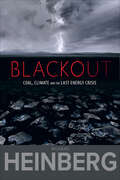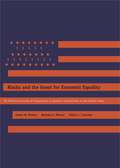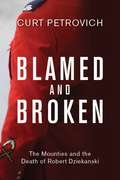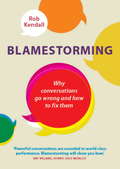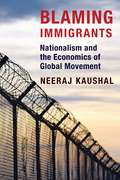- Table View
- List View
Blacklisted
by Dave Smith Phil ChamberlainBlacklisted tells the explosive story of the illegal strategies used by transnational construction companies to deny union activists work.This is the story of a bitter struggle, in which employers' collusion with the police and security services resulted in victimization, violence and unemployment, with terrible effects on families and communities.Investigative journalist Phil Chamberlain and Dave Smith, campaigner and victim of blacklisting, lift the lid on the shameful and immoral practices that went on behind the scaffolding. Hundreds of testimonies (blacklisted workers, Special Branch spies, company representatives, union members and more) and extracts from blacklist files expose the scale of the scandal and the human stories behind the secret war. In forensic detail the authors make a powerful and unequivocal case for human rights and for justice to finally be done.
Blackout: Coal, Climate and the Last Energy Crisis
by Richard HeinbergCoal fuels about 50 percent of US electricity production and provides a quarter of the country's total energy. China and India's ferocious economic growth is based almost entirely on coal-generated electricity.Coal currently looks like a solution to many of our fast-growing energy problems. However, while coal advocates are urging full steam ahead, increasing reliance on the dirtiest of all fossil fuels has crucial implications for the global climate, energy policy, the world economy, and geopolitics.Drawbacks to a coal-based energy strategy include:Scarcity – new studies suggest that the peak of world coal production may actually be less than two decades away.Cost – the quality of produced coal is declining, while the expense of transport is rising, leading to spiraling costs and increasing shortages.Climate impacts - our ability to deal with the historic challenge of climate change will hinge on reducing our coal consumption in future years.Blackout goes to the heart of the tough energy questions that will dominate every sphere of public policy throughout the first half of this century, and is a must-read for planners, educators, and anyone concerned about energy consumption, peak oil and climate change.
Blacks and the Quest for Economic Equality: The Political Economy of Employment in Southern Communities in the United States
by James W. Button Barbara A. Rienzo Sheila L. CroucherThe civil rights movement of the 1960s improved the political and legal status of African Americans, but the quest for equality in employment and economic well-being has lagged behind. Blacks are more than twice as likely as whites to be employed in lower-paying service jobs or to be unemployed, are three times as likely to live in poverty, and have a median household income barely half of that for white households. What accounts for these disparities, and what possibilities are there for overcoming obstacles to black economic progress? This book seeks answers to these questions through a combined quantitative and qualitative study of six municipalities in Florida.Factors impeding the quest for equality include employer discrimination, inadequate education, increasing competition for jobs from white females and Latinos, and a lack of transportation, job training, affordable childcare, and other sources of support, which makes it difficult for blacks to compete effectively. Among factors aiding in the quest is the impact of black political power in enhancing opportunities for African Americans in municipal employment.The authors conclude by proposing a variety of ameliorative measures: strict enforcement of antidiscrimination laws; public policies to provide disadvantaged people with a good education, adequate shelter and food, and decent jobs; and self-help efforts by blacks to counter self-destructive attitudes and activities.
Blackstone Alternative Asset Management
by Robin Greenwood Luis M. Viceira Jared DourdevilleThis case explores reasons for Blackstone Alternative Asset Management's (BAAM's) growth from 2007-2013, a time when the overall fund of hedge funds industry contracted substantially. Additionally, the case analyzes evolving business models and value propositions within the fund of hedge funds industry. J. Tomilson Hill, CEO of BAAM and Vice-Chairman of The Blackstone Group, is the protagonist. At the time of the case, BAAM was considering two potential directions for future growth: 1) providing hedge fund products for the defined contribution pension space, and 2) beginning direct internal "manufacturing" of investments. In the context of the current fund of hedge funds industry, the case considers challenges and opportunities for these potential new areas for growth.
Blackstone Alternative Asset Management in 2018
by Luis M. Viceira Shawn O'Brien Emil Nuwan SiriwardaneIn early 2018, Blackstone announced that John McCormick would succeed Tom Hill as President and Chief Executive Officer of Blackstone Alternative Asset Management (BAAM), the largest fund-of-hedge funds in the world by a sizeable margin. As new CEO, McCormick must decide on strategic growth options for the firm as its traditional FOF business is maturing and growth in its nearly $80 billion in assets under management (AUM) is plateauing. In the recent past, BAAM had expanded into other investing businesses, making direct investments, seeding early-stage hedge funds, taking general partner stakes in investment management firms, and offering alternative investment products to retail investors. To determine the appropriate path forward, McCormick must assess whether BAAM has a competitive edge in each of these platforms, as well as if further expansion could create internal conflicts of interest within BAAM and, more broadly, Blackstone.
Blackstone and the Sale of Citigroup's Loan Portfolio
by David S. Scharfstein Victoria IvashinaThe credit boom that preceded the 2007-2009 financial crisis led to several lending practices that exposed banks to large risks. In particular, when the financial crisis unraveled, there were several billion dollars' worth of leveraged buyout (LBO) loans that were meant to be syndicated but-due to full underwriting-had to be funded by the originating banks. The case protagonist is Bennett J. Goodman, a Senior Managing Director at Blackstone. Goodman evaluates the opportunity to buy a fraction of the leveraged loan portfolio being offered for sale by Citigroup. This case can be used as a vehicle for discussing details of leveraged financing. In particular, it illustrates the close connection between syndicated-lending-backed leveraged transactions and loan securitization, and provides a context for discussion of factors that led to the leveraged credit boom that ended in 2007. The case also provides in-depth details of the structure of the transaction and its underlying assets, and serves as a means for understanding and valuing alternative investment strategies pursued by private equity firms during the credit-market crisis. As a byproduct, students learn how to use credit default swaps (CDS), a market-based indicator, for valuation.
Blackstone at Age 30
by Josh Lerner Amram Migdal John DionneSince its IPO in 2007 and following the global financial crisis, Blackstone largely outpaced its alternative investment firm peers in assets under management, new business launches, profitability, and market capitalization. Under the leadership of Stephen A. Schwarzman, chairman and CEO, and president and COO Hamilton ("Tony") James, Blackstone's growth derived from substantial horizontal expansion into new alternative asset products and services, both organically and through acquisition. These included businesses in private equity, real estate, funds of hedge funds, alternative credit, opportunistic transactions ("Tactical Opportunities"), and secondaries investments. The firm has also innovated in sourcing capital from a variety of limited partners. Blackstone's culture of centralized investment processes and risk management coupled with entrepreneurial leadership contributed to its growth in important ways, but the firm faces important external and internal challenges as it seeks to continue its growth.
Blackstone at Age 30
by Josh Lerner Amram Migdal John D. DionneSince its IPO in 2007 and following the global financial crisis, Blackstone largely outpaced its alternative investment firm peers in assets under management, new business launches, profitability, and market capitalization. Under the leadership of Stephen A. Schwarzman, chairman and CEO, and president and COO Hamilton ("Tony") James, Blackstone's growth derived from substantial horizontal expansion into new alternative asset products and services, both organically and through acquisition. These included businesses in private equity, real estate, funds of hedge funds, alternative credit, opportunistic transactions ("Tactical Opportunities"), and secondaries investments. The firm has also innovated in sourcing capital from a variety of limited partners. Blackstone's culture of centralized investment processes and risk management coupled with entrepreneurial leadership contributed to its growth in important ways, but the firm faces important external and internal challenges as it seeks to continue its growth.
Blackstone's GSO Capital: Crosstex Investment
by Victoria Ivashina Jeffrey Boyar John D. DionneCase
Blackstone's Investment in Intelenet
by Josh Lerner Rachna Tahilyani Sandeep BapatThree years had passed since Blackstone's investment in Intelenet Global Services, their third largest investment in India. Great progress had been made, but now a new challenge loomed. Globank, a large global bank, was Intelenet's largest customer. Intelenet's contract with Globank was set to expire in the next seven months, and all of Intelenet's assets and people working on the account, would move to Globank. Amit Dixit, managing director at the Blackstone Group, estimated that in the next four years this would result in Intelenet losing $160 million of revenue and $48 million of EBITDA. Blackstone could either channel large amounts of capital and human resources towards renewing the contract, or focus on growing third-party business at Intelenet. Dixit had to firm up his strategy quickly in order to begin negotiations with Globank.
Blackstone: Crocs Investment
by Victoria Ivashina Terrence Shu John D. DionneThis case follows Prakash Melwani (HBS MBA '86), CIO of Blackstone's Private Equity Group, and his teams' investment in the footwear company Crocs. Instead of a traditional secondary offering, Crocs opted for a unique deal structure by taking Blackstone's cash in a private investment in public equity (PIPE) deal. During the Blackstone investment, Melwani and his team drastically reworked Crocs' strategy. The case offers insight into the operational initiatives undertaken to revitalize the Crocs brand.
Blackstone’s GSO Capital: Crosstex Investment
by Victoria Ivashina Jeffrey Boyar John D. DionneBlackstone's GSO Capital: Crosstex Investment by Victoria Ivashina, John D. Dionne, Jeffrey Boyar
Blah Blah Blah: What To Do When Words Don't Work
by Dan RoamEver been to so many meetings that you couldn't get your work done? Ever fallen asleep during a bulletpoint presentation? Ever watched the news and ended up knowing less? Welcome to the land of Blah Blah Blah.The Problem: We talk so much that we don't think very well. Powerful as words are, we fool ourselves when we think our words alone can detect, describe, and defuse the multifaceted problems of today. They can't-and that's bad, because words have become our default thinking tool.The Solution: This book offers a way out of blah-blah-blah. It's called "Vivid Thinking."In Dan Roam's first acclaimed book, The Back of the Napkin, he taught readers how to solve problems and sell ideas by drawing simple pictures. Now he proves that Vivid Thinking is even more powerful. This technique combines our verbal and visual minds so that we can think and learn more quickly, teach and inspire our colleagues, and enjoy and share ideas in a whole new way.The Destination: No more blah-blah-blah. Through Vivid Thinking, we can make the most complicated subjects suddenly crystal clear. Whether trying to understand a Harvard Business School class, or what went down in the Conan versus Leno battle for late-night TV, or what Einstein thought about relativity, Vivid Thinking provides a way to clarify anything.Through dozens of guided examples, Roam proves that anyone can apply this systematic approach, from leftbrain types who hate to draw to right-brainers who hate to write. This isn't just a book about improving communications, presentations, and ideation; it's about removing the blah-blah- blah from your life for good.
Blaine Kitchenware, Inc.: Capital Structure (Brief Case)
by Timothy A. Luehrman Joel L. HeilprinA diversified mid-sized manufacturer of kitchen tools contemplates a stock repurchase in response to an unsolicited takeover. The company must determine the optimal debt capacity and capital structure, and subsequently estimate the resulting change in firm value and stock price. Attention is also given to the value of interest tax shields.
Blake Sports Apparel and Switch Activewear: Bringing the Executive Team Together
by Boris Groysberg Katherine Connolly BadenCameron (Cam) Barker, founder and CEO of Blake Sports Apparel and Switch Activewear, manufacturers and distributers of sports apparel and accessories, was facing a challenge with his executive team. Their inability to work together on seemingly simple issues was a chronic problem. Although they were a competent group of executives, most of whom had been with Barker for a number of years and had played an integral role in the growth of his company, the team's dynamics were dysfunctional. Lack of communication, mistrust, and refusal to collaborate were some of their biggest challenges. Barker had had enough and was ready to take action, but what action should he take? How could he teach the executive team to work together? Did he have the right people in the right roles? Was the team appropriately structured and managed? How could Barker bring his executive team together in order to maximize performance and face the challenges and opportunities that would be presenting themselves to his young company in the months and years ahead?
Blake Sports Apparel and Switch Activewear: Bringing the Executive Team Together
by Boris Groysberg Katherine Connolly BadenCameron (Cam) Barker, founder and CEO of Blake Sports Apparel and Switch Activewear, manufacturers and distributers of sports apparel and accessories, was facing a challenge with his executive team. Their inability to work together on seemingly simple issues was a chronic problem. Although they were a competent group of executives, most of whom had been with Barker for a number of years and had played an integral role in the growth of his company, the team's dynamics were dysfunctional. Lack of communication, mistrust, and refusal to collaborate were some of their biggest challenges. Barker had had enough and was ready to take action, but what action should he take? How could he teach the executive team to work together? Did he have the right people in the right roles? Was the team appropriately structured and managed? How could Barker bring his executive team together in order to maximize performance and face the challenges and opportunities that would be presenting themselves to his young company in the months and years ahead?
Blake Sports: Evolution of the CEO and the Executive Team
by Boris Groysberg Katherine Connolly BadenCameron (Cam) Barker, CEO and Founder of Blake Sports Apparel, sat in his office at his company's headquarters in Birmingham, England, feeling stunned and disappointed. Only a few minutes prior, he had wrapped up a meeting with CFO James Ryan, a highly-respected star executive who had just abruptly given Barker his notice of resignation. When Barker hired Ryan in November 2020, he had asked Ryan not to take the position unless he intended to stay for at least five years, which Ryan agreed was his plan. Yet, here Barker was just eighteen months later and Ryan was ready to walk out the door, citing Barker's leadership style as one factor in his decision to leave. After years of struggling to find the right executive team structure and size and to fill the positions with the right people, Barker thought he had finally gotten it right. The executive team had proved that they were capable of communicating, collaborating and making smart decisions in ways that put the organization's priorities ahead of their own. Furthermore, Ryan had proven himself to be just the kind of CFO the growing company needed. Baker knew his departure was a loss. Why did Ryan resign? What issues had he taken with Barker's leadership? Should Barker take Ryan's feedback to heart, or was it simply a case of conflicting styles? After years of managing dysfunctional executive teams, did Barker need to change the way he managed his reports now that his executive team was collaborative and high-performing? If so, how?
Blame: How Can I Convince Others That It's Their Fault?--Overcoming the "Blame Reflex" to Achieve Personal Growth
by Thomas J. DelongDo you find yourself wondering how to assign blame every time something goes wrong? Many smart, accomplished professionals find it difficult to hear that they've made a mistake or that they haven't met expectations; that they may need to change to do better next time. Blaming others is an easy way out--but it may be keeping you from the reflection and self-assessment that allow you to learn, change, and grow. In this chapter, organizational behavior expert Tom DeLong explores the anxieties and assumptions--many of them common to high-need-for-achievement individuals--that underlie our need to deflect blame when things go wrong. Filled with vivid examples, self-assessment questions, and practical advice, this chapter is a virtual how-to manual for rising above the blame game and, in the process, bringing you personal and professional rewards. This chapter was originally published as Chapter 8 of "Flying Without a Net: Turn Fear of Change into Fuel for Success."
Blamed and Broken: The Mounties and the Death of Robert Dziekanski
by Curt PetrovichA few fleeting seconds, captured on video, led to a frustrating search for justice tainted by ego, bias, and a desire for vengeance. Images of Robert Dziekanski convulsing after being shocked by a Mountie’s Taser went viral in 2007. International outrage and domestic shame followed the release of that painful video. It had taken just twenty-six seconds for four Mounties to surround and stun the Polish would-be immigrant at Vancouver International Airport. A decade later, after millions of dollars spent on an inquiry, and bungled prosecutions laden with bias and interference, the tragic impact of those fleeting seconds on the people involved — Dziekanski's mother and the four Mounties — is at last revealed.
Blamestorming
by Rob KendallBlamestorming outlines the reasons why our daily conversations go wrong, explains how to respond when they do and provides tips on how to stop them going wrong in the first place. Based on his experience as a highly respected communications coach for international companies and business professionals, Rob Kendall provides a practical guide to achieving more rewarding and effective interactions with everyone in your life - from your boss to your partner. Rob's techniques have been proven to be effective for thousands of people from all walks of life and are presented in an illustrated step-by-step format that makes them easy to put into practice from Day One. Underpinning the book's approach to consistently having better interactions is an explanation of the warning signals that indicate when a conversation is going off track.
Blamestorming
by Rob KendallWinner of the 2015 COVR Award for Best Self-Help Book!Blamestorming outlines the reasons why our daily conversations go wrong, explains how to respond when they do and provides tips on how to stop them going wrong in the first place. Based on his experience as a highly respected communications coach for international companies and business professionals, Rob Kendall provides a practical guide to achieving more rewarding and effective interactions with everyone in your life - from your boss to your partner. Rob's techniques have been proven to be effective for thousands of people from all walks of life and are presented in an illustrated step-by-step format that makes them easy to put into practice from Day One. Underpinning the book's approach to consistently having better interactions is an explanation of the warning signals that indicate when a conversation is going off track.From the Trade Paperback edition.
Blamestorming
by Rob KendallWinner of the 2015 COVR Award for Best Self-Help Book!Blamestorming outlines the reasons why our daily conversations go wrong, explains how to respond when they do and provides tips on how to stop them going wrong in the first place. Based on his experience as a highly respected communications coach for international companies and business professionals, Rob Kendall provides a practical guide to achieving more rewarding and effective interactions with everyone in your life - from your boss to your partner. Rob's techniques have been proven to be effective for thousands of people from all walks of life and are presented in an illustrated step-by-step format that makes them easy to put into practice from Day One. Underpinning the book's approach to consistently having better interactions is an explanation of the warning signals that indicate when a conversation is going off track.From the Trade Paperback edition.
Blaming Immigrants: Nationalism and the Economics of Global Movement
by Neeraj KaushalImmigration is shaking up electoral politics around the world. Anti-immigration and ultranationalistic politics are rising in Europe, the United States, and countries across Asia and Africa. What is causing this nativist fervor? Are immigrants the cause or merely a common scapegoat?In Blaming Immigrants, economist Neeraj Kaushal investigates the rising anxiety in host countries and tests common complaints against immigration. Do immigrants replace host country workers or create new jobs? Are they a net gain or a net drag on host countries? She finds that immigration, on balance, is beneficial to host countries. It is neither the volume nor pace of immigration but the willingness of nations to accept, absorb, and manage new flows of immigration that is fueling this disaffection. Kaushal delves into the demographics of immigrants worldwide, the economic tides that carry them, and the policies that shape where they make their new homes. She demystifies common misconceptions about immigration, showing that today’s global mobility is historically typical; that most immigration occurs through legal frameworks; that the U.S. system, far from being broken, works quite well most of the time and its features are replicated by many countries; and that proposed anti-immigrant measures are likely to cause suffering without deterring potential migrants. Featuring accessible and in-depth analysis of the economics of immigration in worldwide perspective, Blaming Immigrants is an informative and timely introduction to a critical global issue.

